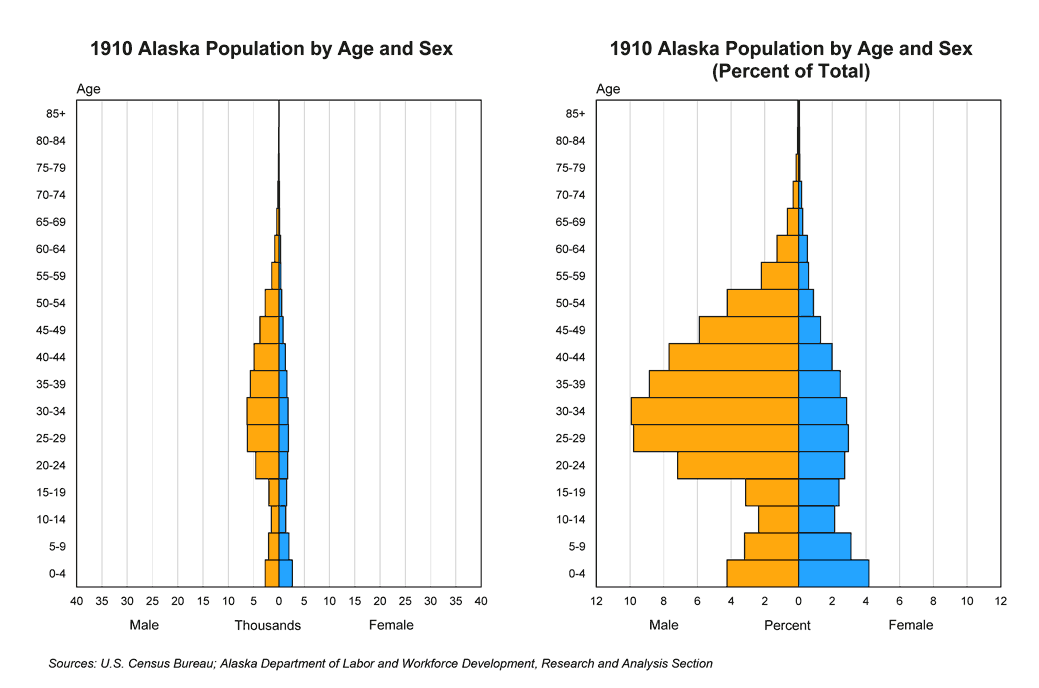
100 Years of Census Data: Population Pyramids Show Alaska's Dramatic Transformation
With each census, population counts by selected characteristics are made. Two characteristics that have been consistently counted in Alaska since 1910 are age and sex. These age and sex data are a favorite tool of population researchers because they can give useful information about an area's population, including potential workforce size, size of the dependent (non-workforce) population and the impact of historical events. Combined with data on births and deaths they can give information on family size, life expectancy and net migration.
A "population pyramid" is a graph that shows population data by age and sex. Change in Alaska's population pyramid over the decades is striking, reflecting the massive socioeconomic change that our state has experienced. From 1910, when the "District of" Alaska's population was just 64,000 (less than one tenth of today's) and its economic activity was largely from mining and canneries, we see a greatly skewed ratio of males to females-- nearly two and a half men per woman. The skew is not attributable to the Alaska Native population, which made up more than a third of the state total at the time, but to the non-Native population. Alaska must have remained attractive to many sourdoughs though, as we can see in the 1910 and 1930 census data a pattern of increase by age that indicates a significant portion stayed. With the end of the gold rush era to 1930 there was an actual decrease in Alaska's total population, but it should be noted the Alaska Native population saw increase, from approximately 25,000 in 1910 to 30,000 in 1930, making up more than half the state total at that time.
Between 1940 and 1950 we see effects of World War II and the start of the Cold War on Alaska's population. The state total increased by more than 75% in those years, the most for any of the periods, and we see a substantial proportion of residents were 20-24 year old GI's. Through statehood to 1970, when our nation's military was built up for the Korean and then Vietnam War, and the effects of the discovery at Prudhoe Bay were still to come, men just out of high school remained the biggest age group in the state. Many servicemen would stay or return to Alaska with families, and big events were in store for their new home.
1970 to 1980 saw construction of the massive Trans-Alaska Pipeline System ("TAPS"), and the state's largest recorded turnover of population. From annual estimates we know that the state netted more than 30,000 new residents in a single year (1974-1975), and had a net loss of more than 13,000 just three years later. Overall for the decade Alaska gained more than 100,000 people, and we can see the population's composition changed greatly. By 1980 Alaska had an age-sex distribution more like the nation as a whole, with a less skewed male to female ratio and still a large proportion of "baby boomers" (people born between 1946 and 1964). From other census data we know that the population was more urban, and though the Alaska Native population continued steady increase, it was now just over 15 percent of the state's roughly 400,000 person total.
Alaska in the 1980's saw huge economic growth from TAPS and high oil prices, followed by a dramatic economic downturn when those prices dropped, and finally the start of a recovery. On the whole, the state gained nearly 150,000 people over the decade, the largest number for any period. While migration played a huge role in the change, so did the shape of that population pyramid: with a large proportion of baby boomers aged 20-39 came an increase in Alaska births and a large generation that is often termed the "echo boomers" (children of the baby boomers).
Since 1990 Alaska has seen less significant change that can be tied to individual events, but has continued its dramatic transformation. We see the population has aged, and with its large proportion of baby boomers the state is now at the beginning of a massive increase in the number of people ages 65 or more. Many echo boomers moved from the state in the 2000's for college and other opportunities, and many are now returning and again adding to the state's population, and its workforce. Due in part to military buildups we see a higher male to female ratio in 2010 than 2000, the first increase since the military growth between 1940 and 1950. The Alaska Native (alone) population is now estimated at nearly 105,000. No doubt Alaska is a state defined by its great booms and busts, but even without them we experience great change.
From all of the events and unfolding of history the Alaska of 1910 and of 2010 are in many respects incomparable with one another, and yet the state truly remains a sparsely-settled frontier, and the transformation of its population continues.
–Eddie Hunsinger, January 2012 (updated July 2017)
Eddie Hunsinger
|